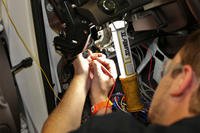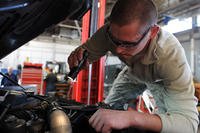by Lou Cataldo
Jump Links
- The Audi Quattro Spyder Concept: An Overview
- The Quattro Spyder Concept's Development
- The Production Model That Gave The Quattro Spyder Its Engine: The Audi 100
- The Perfect Daily Supercar: The Audi R8
Concept cars are one of the most interesting ways for car enthusiasts to gain insight into what an automaker wants to develop in the future, from design to technology to propulsion methods. Nearly three and a half decades ago, Audi unveiled a fascinating concept car called the Quattro Spyder. This concept showcased the direction the brand wanted to go in: it had a futuristic look and a dual character, being somewhat of a halfway point between a supercar and an everyday vehicle.
If the Quattro Spyder had moved into the production stage, it could have made an amazing “daily supercar”: a model that includes the characteristics of both a sporty, performance-oriented car and a comfortable daily driver capable of handling the everyday commute. This sadly did not come to pass. However, Audi embodied the “daily supercar” philosophy in other ways, most notably through the R8. Let’s take a look back at the Quattro Spyder concept’s history and features.
The Audi Quattro Spyder Concept: An Overview

Audi
The Audi Quattro Spyder was a concept car introduced in 1991, designed as a potential successor to the Quattro. Unlike the Quattro, which was famous for its angular, squared-off silhouette, the Quattro Spyder had a sleek, aerodynamic design. In terms of looks, its closest relative in the Audi family was another concept car that was being developed around the same time: the Avus Quattro. Like the Quattro Spyder, however, the Avus Quattro also never resulted in a production model.

Audi
One of the Quattro Spyder’s most innovative characteristics was its lightweight aluminum body, which showcased Audi’s state-of-the-art aluminum construction technology. A few years later, in 1997, Audi would make use of its aluminum bodywork manufacturing techniques for the A2, a futuristic little family car that was never fully appreciated by the automotive world.
The Quattro Spyder also had another notable feature, which it got the latter half of its name from: the removable glass roof panels, which could be fastened in place above the engine cover. The car was finished in a striking shade of orange, while the back of the roof and the engine cover were dark gray. The interior was minimalistic and sleek, with plenty of aluminum elements and bucket seats upholstered in dark gray fabric.
Power came from a 2.8-liter V6 engine borrowed from an Audi production model, the 100. More specifically, this engine came from the Audi 100’s fourth and last generation, the C4, which was in production between 1990 and 1994. The engine was paired with a five-speed manual transmission, and produced 172 hp.
The Quattro Spyder Concept's Development

Audi
The development process that led to the creation of the Quattro Spyder concept began at the start of 1990, while Audi was looking to build a replacement for the aging Quattro. The Quattro was coming up to a decade old, and would reach the end of its production run the following year. Audi already had a successor model in the pipeline, the S2, but it was looking to develop something even sportier that embodied the Quattro’s characteristics.
Eventually, the Quattro Spyder concept was revealed in 1991 at the Frankfurt Motor Show, and Audi began making plans to turn it into a production model. Around 3,000 prospective customers are said to have placed a pre-order for the Quattro Spyder following the concept car’s introduction. However, the planned production run would never become a reality.

Audi
The Quattro Spyder never became a production model due to a combination of several factors. One of the main reasons behind its failure to launch was that the numbers simply didn’t work: due to high production costs, Audi quickly realized it would struggle to meet its target sales price of 100,000 German marks (or around $55,000).
Another important factor was the availability of Audi’s subcontractors. Although Audi’s plan involved potentially hiring subcontractors such as Porsche or Karmann to contribute to the construction of the new model, these companies did not have the capacity to handle the Quattro Spyder’s projected production run of 25,000 units.
The discontinuation of the Quattro Spyder was also a family matter: Audi’s CEO at the time was Ferdinand Piech, a grandson of Porsche’s founder Ferdinand Porsche. Porsche was going through a difficult period at the time, and Piech was worried that the Quattro Spyder would be so successful a rival it would contribute to the company’s troubles. In the end, the Quattro Spyder was killed off for good in 1992, never making it past the concept stage.
Read the full article on CarBuzz
This article originally appeared on CarBuzz and is republished here with permission.










